Abstract
We analyzed intraspecific diversity of Indian anchovy, Stolephorus indicus, a commercially and ecologically important species, using mitochondrial DNA markers so as to derive insights into population structuring and historical demography. Analyses were carried out on 128 and 138 individuals collected from 5 locations along the range of distribution using mitochondrial ATPase (843 bp) and COI (663 bp) sequences respectively. Significant connectivity and gene flow was detected among fishes collected from all the geographic locations as indicated by lack of structuring in Bayesian clustering analysis along with insignificant ΦST values. Oceanographic features of the Bay of Bengal, Arabian Sea and Andaman Sea may be favorable for the dispersal of anchovy larvae and subsequent gene flow. Historical demographic analyses indicated a demographic and spatial expansion taken place approximately during 125,000 years before present, the Pleistocene epoch. Indian Ocean witnessed emergence of upwelling events and consequent increase in productivity during the Pleistocene epoch causing a demographic and spatial expansion of anchovies. Management measures for this species should be devised considering it as a single stock along its entire range of distribution.




Similar content being viewed by others
References
Agostini VN, Bakun A (2002) Ocean triads in the Mediterranean Sea: physical mechanisms potentially structuring reproductive habitat suitability (with example application to European anchovy, Engraulis encrasicolus). Fish Oceanogr 11:129–142
Bakun A, Roy C, Lluch-Cota S (1998) Coastal upwelling and other processes regulating ecosystem productivity and fish production in the western Indian Ocean. In: Sherman K, Okemwa E, Nitiba MM (eds) Large marine ecosystems of the Indian Ocean: assessment, sustainability and management. Blackwell Sciences Inc, Massachusettes, pp 103–141
Barange M, Coetzee J, Takasuka A, Hill K, Gutierrez M, Oozeki Y, Van der Lingen C, Agostini V (2009) Habitat expansion and contraction in anchovy and sardine populations. Prog Oceanogr 83:251–260
Brennan RS, Hwangn R, Tse M, Fangue NA, Whitehead A (2016) Local adaptation to osmotic environment in killifish, Fundulus heteroclitus, is supported by divergence in swimming performance but not by differences in excess post-exercise oxygen consumption or aerobic scope. Comp Biochem Physiol A Mol Integr Physiol 196:11–19
Burridge CP, Craw D, Fletcher D, Waters JM (2008) Geological dates and molecular rates: fish DNA sheds light on time dependency. Mol Biol Evol 25:624–633
Candy JR, Campbell NR, Grinnell MH, Beacham TD, Larson WA, Narum SR (2015) Population differentiation determined from putative neutral and divergent adaptive genetic markers in Eulachon (Thaleichthys pacificus, Osmeridae), an anadromous Pacific smelt. Mol Ecol Resour 15:1421–1434
Chatterjee A, Shankar D, McCreary JP, Vinayachandran PN, Mukherjee A (2017) Dynamics of Andaman Sea circulation and its role in connecting the equatorial Indian Ocean to the Bay of Bengal. J Geophys Res Oceans 122(4):3200–3218
Checkley DM Jr, Asch RG, Rykaczewski RR (2017) Climate, anchovy, and sardine. Annu Rev Mar Sci 9:469–493
CMFRI (2017) CMFRI annual report 2016–2017. Central Marine Fisheries Research Institute, Kochi
Corander J, Marttinen P, Sirén J, Tang J (2008) Enhanced Bayesian modelling in BAPS software for learning genetic structures of populations. BMC Bioinform 9:539. https://doi.org/10.1186/1471-2105-9-539
Delrieu-Trottin E, Mona S, Maynard J, Neglia V, Veuille M, Planes S (2017) Population expansions dominate demographic histories of endemic and widespread Pacific reef fishes. Sci Rep 7:40519. https://doi.org/10.1038/srep40519
Devaraj M, Kurup KN, Pillai NGK, Balan K, Vivekanandan E, Sathiadas R (1997) Status, prospects and management of small pelagic fisheries of India. In: Devaraj M, Martosubroto P (eds) Small pelagic resources and their fisheries in the Asia-Pacific Region. Proceedings of APFIC working party on Marine Fisheries, RAP Publishers, Thailand, pp 91–198
Drummond AJ, Rambaut A, Shapiro B, Pybus OG (2005) Bayesian coalescent inference of past population dynamics from molecular sequences. Mol Biol Evol 22:1185–1192
Drummond AJ, Suchard MA, Xie D, Rambaut A (2012) Bayesian phylogenetics with BEAUti and the BEAST 1.7. Mol Biol Evol 29:1969–1973
Excoffier L, Smouse PE, Quattro JM (1992) Analysis of molecular variance inferred from metric distances among DNA haplotypes: application to human mitochondrial DNA restriction data. Genetics 13:479–491
Folmer O, Black M, Hoeh W, Lutz R, Vrijenhoek R (1994) DNA primers for amplification of mitochondrial cytochrome c oxidase subunit I from diverse metazoan invertebrates. Mol Mar Biol Biotechnol 3:294–299
Fricke R, Golani D, Appelbaum-Golani B (2015) First record of the Indian anchovy Stolephorus indicus (van Hasselt, 1823) (Clupeiformes: Engraulidae) in the Mediterranean Sea. BioInvasions Rec 4:293–297
Fu YX (1997) Statistical tests of neutrality of mutations against population growth, hitchhiking and background selection. Genetics 147:915–925
Grant WS, Leslie RW, Bowen BW (2005) Molecular genetic assessment of bipolarity in anchovy genus Engraulis. J Fish Biol 67:1242–1265
Harpending RC (1994) Signature of ancient population growth in a low resolution mitochondrial DNA mismatch distribution. Hum Biol 66:591–600
Hauser L, Turan C, Carvalho GR (2001) Haplotype frequency distribution and discriminatory power of two mtDNA fragments in a marine pelagic teleost (Atlantic herring, Clupea harengus). Heredity 87:621–630
Jayaprakash AA (2004) Status of exploited marine fishery resources of India. In: Modayil MJ, Jayaprakash AA (eds) Status of exploited marine fishery resources of India. Central Marine Fisheries Research Institute, Kochi, pp 30–37
Kitada S, Nakajima K, Hamasaki K (2017) Population panmixia and demographic expansion of a highly piscivorous marine fish Scomberomorus niphonius. J Fish Biol 91:1435–1448
Mantel N (1967) The detection of disease clustering and a generalized regression approach. Cancer Res 27:209–220
Mohamed KS, Zacharia PU, Maheswarudu G, Sathianandan TV, Abdussamad EM, Ganga U, Lakshmi PS, Sobhana KS, Nair RJ, Jose J, Chakraborty RD, Kizhakudan S, Najmudeen TM (2014) Minimum legal size (MLS) of capture to avoid growth overfishing of commercially exploited fish and shellfish species of Kerala. Mar Fish Inf Serv 220:3–7
Nei M (1987) Molecular evolutionary genetics. Columbia University Press, NewYork
Nei M, Tajima F (1981) DNA polymorphism detectable by restriction endonucleases. Genetics 97(1):145–163
Ouazzani KC, Benazzou T, Tojo N, Chlaida M (2015) Mitochondrial phylogenomics and genetic population structure of anchovies (Engraulis encrasicolus) along the Moroccan coast using sequence analysis of the mitochondrial DNA cytochrome b. Peer J PrePrints 3:e1543v1
Oueslati S, Fadhlaoui ZK, Kada O, Augé MT, Quignard JP, Bonhomme F (2014) Existence of two widespread semi-isolated genetic entities within Mediterranean anchovies. Mar Biol 161:1063–1071
Page TJ, Suman S, Hughes JM (2004) Deep phylogenetic structure has conservation implications for ornate rainbow fish (melanotaeniidae; Rhadinocentrus ornatus) in Queensland, eastern Australia. Mar Freshwater Res 55:165–172
Peterson GI, Masel J (2009) Quantitative prediction of molecular clock and Ka/Ks at short timescales. Mol Biol Evol 26:2595–2603
Rai AK, Singh VB (2012) Response of eastern Indian Ocean (ODP Site 762B) benthic foraminiferal assemblages to the closure of the Indonesian seaway. Oceanologia 54:49–472
Rambaut A, Drummond AJ, Xie D, Baele G, Suchard MA (2018) Posterior summarisation in Bayesian phylogenetics using Tracer 1.7. Syst Biol 67:901–904. https://doi.org/10.1093/sysbio/syy032
Rice WR (1989) Analyzing tables of statistical tests. Evolution 43:223–225
Roberts DG, Ayre DJ (2010) Panmictic population structure in the migratory marine sparid Acanthopagrus australis despite its close association with estuaries. Mar Ecol Prog Ser 412:223–230
Rogers AR, Harpending H (1992) Population growth makes waves in the distribution of pairwise genetic differences. Mol Biol Evol 9:552–569
Rozas J, Sanchez-DelBarrio JC, Messeguer X, Rozas R (2003) DnaSP, DNA polymorphism analysis by the coalescent and other methods. Bioinformatics 19:2496–2497
Ruzzante DE, Mariani S, Bekkevold D, Andre C, Mosegaard H, Clausen LAW, Dahlgren TG, Hutchinson WF, Hatfield EMC, Torstensen E, Brigham J, Simmonds EJ, Laikre L, Larsson LC, Stet RJM, Ryman N, Carvalho GR (2006) Biocomplexity in a highly migratory pelagic marine fish, Atlantic herring. Proc R Soc Lond B 273:1459–1464
Sambrook J, Russell DW (2001) Molecular cloning: a laboratory manual. Cold Spring Harbor Laboratory Press, Cold Spring Harbor, New York
Schneider S, Excoffier L (1999) Estimation of past demographic parameters from the distribution of pairwise differences when the mutation rates vary among sites: application to human mitochondrial DNA. Genetics 152:1079–1089
Schneider S, Roessli D, Excoffier L (2000) Arlequin version 2.000: a software for population genetics data analysis. Genetics and Biometry Laboratory, University of Geneva, Geneva
Silva G, Horne JB, Castilho R (2014) Anchovies go north and west without losing diversity: post-glacial range expansions in a small pelagic fish. J Biogeogr 41:1171–1182
Sinha DK, Singh AK (2007) Surface circulation in the eastern Indian ocean during last 5 million years: planktic foraminiferal evidences. Indian J Mar Sci 35(3):342–350
Slatkin M (1991) Inbreeding coefficients and coalescence times. Genet Res Camb 58:167–175
Stephenson RL (1999) Stock complexity in fisheries management: a perspective of emerging issues related to population sub-units. Fish Res 43:247–249
Stern N, Douek J, Goren M, Rinkevich B (2017) With no gap to mind: a shallow genealogy within the world’s most widespread small pelagic fish. Ecography 41:491–504
Sukumaran S, Sebastian W, Gopalakrishnan A (2016) Population genetic structure of Indian oil sardine, Sardinella longiceps along Indian coast. Gene 576:372–378
Tajima F (1983) Evolutionary relationship of DNA sequences in finite populations. Genetics 105:437–460
Tajima F (1989) Statistical methods for testing the neutral mutation hypothesis by DNA polymorphism. Genetics 123:585–595
Teacher AGF, Andre C, Jonsson PR, Merila J (2013) Oceanographic connectivity and environmental correlates of genetic structuring in Atlantic herring in the Baltic Sea. Evol Appl 6:549–567
Varkey MJ, Murty VSN, Suryanarayana A (1996) Physical oceanography of the Bay of Bengal and Andaman Sea. Oceanogr Mar Biol 34:1–70
Veríssimo A, Sampaio I, McDowell JR, Alexandrino P, Mucientes G, Queiroz N, da Silva C, Jones CS, Noble LR (2017) World without borders; genetic population structure of a highly migratory marine predator, the blue shark (Prionace glauca). Ecol Evol 7:4768–4781
Vinas J, Sanz N, Penarrubia L, Araguas RM, Garcia-Marin JL, Roldan MI, Pla C (2013) Genetic population structure of European anchovy in the Mediterranean Sea and the Northeast Atlantic Ocean using sequence analysis of the mitochondrial DNA control region. ICES J Mar Sci 71:391–397
White TA, Fotherby HA, Stephens PA, Hoelzel AR (2011) Genetic panmixia and demographic dependence across the North Atlantic in the deep-sea fish, blue hake (Antimora rostrata). Heredity 106:690–699
Whitehead PJP, Nelson GJ, Wongratana T (1988) FAO species catalogue vol 7. Clupeoid fishes of the world (Suborder Clupeoidei). An annotated and illustrated catalogue of herrings, sardines, pilchards, sprats, anchovies and wolf herrings. Part 2. Engraulidae. FAO fisheries synopsis (125) vol 7. FAO, Rome
Acknowledgements
This work was funded by the Indian Council of Agricultural Research (ICAR) and carried out as part of the institute project MBTD/GEN/28 at Central Marine Fisheries Research Institute, India. The authors would like to thank Dr. P. Vijayagopal (Head, Marine Biotechnology Division, CMFRI), and Director, CMFRI for providing facilities for carrying out this work. Wilson Sebastian received Senior Research Fellowship from ICAR-NICRA project. We also acknowledge the help rendered by Dr. Muktha Menon, Scientist, CMFRI, Dr. Shardul Gangan, Assistant Professor, Taraporewala marine biological research station and Dr. G.B. Sreekanth, ICAR - CCARI in collecting samples of anchovy.
Author information
Authors and Affiliations
Corresponding author
Ethics declarations
Conflict of interest
The authors declare that they have no conflict of interest.
Ethical approval
All applicable international, national, and/or institutional guidelines for the care and use of animals were followed by the authors.
Additional information
Publisher's Note
Springer Nature remains neutral with regard to jurisdictional claims in published maps and institutional affiliations.
Electronic supplementary material
Below is the link to the electronic supplementary material.
Rights and permissions
About this article
Cite this article
Sukumaran, S., Sebastian, W., Francis, K.X. et al. Contemporary and historic patterns of intraspecific diversity in Indian anchovy, Stolephorus indicus, from Indian peninsular waters. Genetica 147, 259–267 (2019). https://doi.org/10.1007/s10709-019-00068-0
Received:
Accepted:
Published:
Issue Date:
DOI: https://doi.org/10.1007/s10709-019-00068-0




